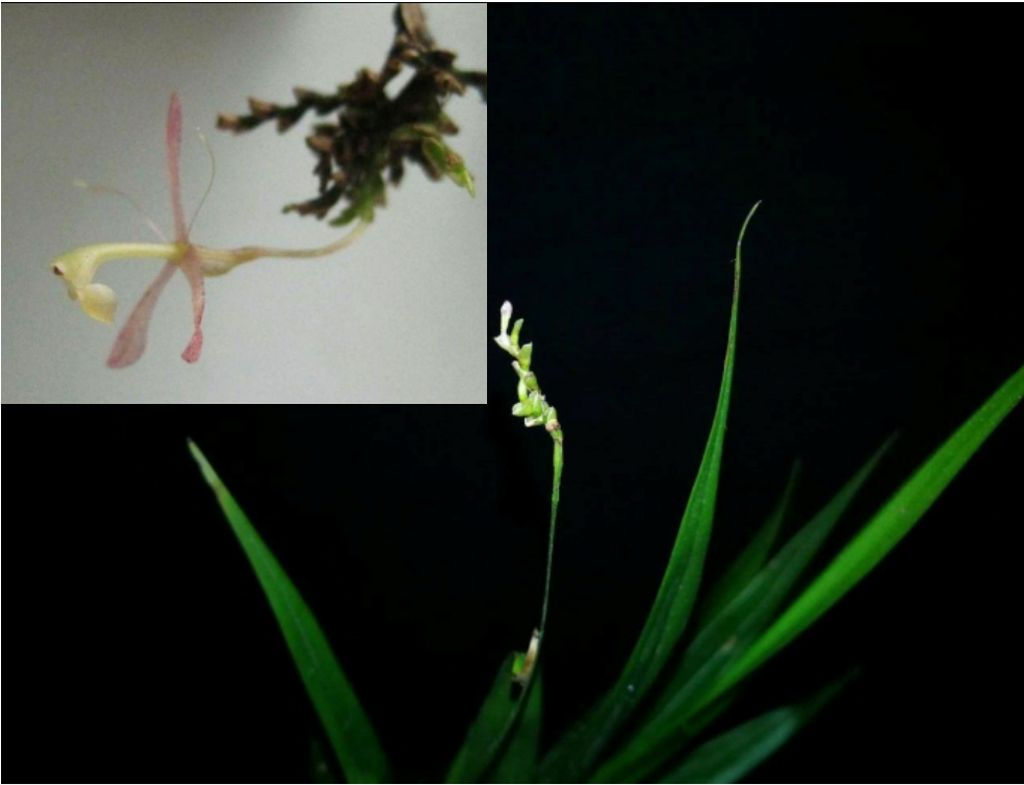

Epidendrum villanuevae Rinc.-González, O.Melo, Hágsater & E.Santiago 2018 GROUP Albertii SUBGROUP Allenii
TYPE Drawing TYPE Photo by © M. Rincón G./TYPE Drawing © by R Jimenenz and The AMO Herbario Website

 LATER
LATER
Common Name Villanueva's Epidendrum [Colombian forestry engineer at the Dendrology Laboratory of the Universidad del Tolima, Colombia, and highly knowledgeable in the Flora of Colombia. He also participated in the collection of the type. Current]
Flower Size .6" [1 cm]
Found in Valle del Cauca department of Colombia on pacific coastal plain in rain forests at elevations of 80 to 200 meters as a medium sized, hot growing epiphyte with cane-like, simple, straight, thin, basal half terete, ancipitose towards the apex stems carrying 4 to 7, distributed along the apical half of the stem, the basal one smaller, green, concolor tubular, ancipitose, striated leaf base sheaths; blade linear-lanceolate, long acuminate, with a central vein and a pair of evident secondary veins on the upper face, margin entire leaves that blooms in the later spring on a terminal, arising through a single, at the apex of the peduncle of the inflorescence, narrowly elliptic, obtuse, conduplicate spathe, peduncle 9.2 to 12" [23 to 30 cm] long, thin, ancipitose, two-winged, progressively narrower, thin, the apex with a single spathe; racemes ca. .4 to .6" [1.0 to 1.5 cm] long, short, densely few-flowered, rachis not totally hidden by the floral bracts, flexuous, 9.6 to 13" [24 to 32.5 cm] long, apical, pluri-racemose, arching pendant, producing 4 or more racemes from the apex of the peduncle, within the spathe, successively single, 1 at a time per raceme at a time, few flowered inflorescence with . shorter than the ovary, not imbricated, but neither loosely spaced, infundibuliform, widely triangular, oblique, dorsally carinate, distichous, apex sub-acute, persistent on the rachis after flowering, pale green floral bracts and carrying resupinate, pale pink flowers with the apex of the sepals slightly marked with magenta, translucent, column and lip greenish cream, ovary greenish cream colored tinged with rose.
"Epidendrum villanuevae belongs to the 2018 GROUP Albertii which is characterized by the sympodial habit, laterally compressed to ancipitose or somewhat fusiform-thickened stems, the apical or apical and lateral racemose, distichous inflorescence more or less with imbricating bracts on the peduncle, producing one flower at a time, and the 2018 Albertii SUBGROUP Alleniiwhich is characterized by the stems with numerous leaves, the inflorescence apical (rarely lateral), peduncle elongated, bare, non-bract bearing, two-winged, the rachis short, covered by rounded, usually imbricating bracts. The species is recognized by the thin, elongate, two-winged peduncle of the inflorescence (that occupies 2/3 of the total length of the plant), the small floral bracts, .04 to .08" [1 to 2 mm] long, distributed along the rachis, infundibuliform, widely triangular, oblique, apex sub-acute, dorsally carinate, not imbricated, which are reminiscent of the floral glumes of some Fimbristylis species (Cyperaceae) and other sedges, the translucent pink flowers with the column and lip cream colored (tinged pale green on the dorsal surface of the column), the lip convex, widely cordiform with the apex truncate forming a 90° angle with the column in natural position, and the disc with 5 ribs that disappear towards the center of the lip. Epidendrum macrophysum Hágsater, O.Pérez & E.Santiago has .16 to .184" [4.0 to 4.6 mm] long floral bracts, densely aggregate and imbricated on a short rachis, flowers pale green, concolor, the margin of the sepals strongly revolute, and the lip is 3-ribbed, the ribs unequal in size. Epidendrum jefeallenii Hágsater & García-Cruz from Panama, which has more ancipitose peduncles, two-winged, the wings prominent; the inflorescence with larger racemes with 5 to 10 successive flowers; ovary slightly inflated in the apical third and a cordiform lip with emarginate apex, .16 to .2" x .2.to .24" [4 to 5 x 5 to 6 mm], with a single rib spreading from the base to the half of the lip. It is also similar to Epidendrum adnatum Ames & C.Schweinf., from Costa Rica and Panama, which has shorter inflorescences with ancipitose peduncles, two-winged, the wings prominent towards the base; an ovary dilated just behind the perianth; oblanceolate, sub-acute, mucronate, sepals; and a ovate, sub-acute, apiculate lip with the margin slightly erose. Epidendrum timbiquiense Hágsater & E.Santiago has an ancipitose peduncle, floral bracts are 2-4 mm long, elliptic, apex rounded, imbricated, flowers are whitish, the white lip somewhat tinged with greenish brown, rounded with base cordate, disc 3-ribbed." Hagsater etal 2018
Synonyms
References W3 Tropicos, Kew Monocot list , IPNI ; *Icones Orchidacearum 16[1] Plate 1665 Hagsater & Sanchez 2018 drawing/photo fide;
----------------------------------------------------------------------------------------------------------